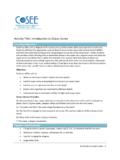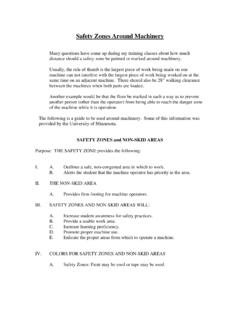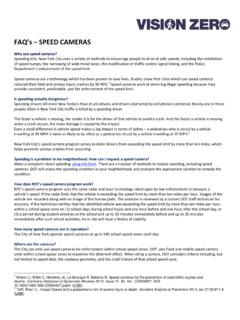Transcription of RELIEF VALVES AND VENTS: HOW EXIT …
1 QUESTRELIEF VALVES AND VENTS: HOW exit conditions affect HAZARD ZONESJohn B. Cornwell, David W. Johnson, and William E. MartinsenPresented AtAmerican Institute of Chemical Engineers1990 Summer National MeetingSan Diego, CaliforniaAugust 19-22, 1990 Presented ByQuest Consultants Inc. 908 26th Avenue , Oklahoma 73069 Telephone: 405-329-7475 Fax: 405-329-7734E-mail: 1990, Quest Consultants Inc., 908 26th Ave., NW, Norman, Oklahoma 73069, USAAll rights reserved. Copyright is owned by Quest Consultants Inc. Any person is hereby authorized to view, copy, print, and distribute documentssubject to the following may be used for informational purposes may only be used for non-commercial document copy or portion thereof must include this copyright noticeQUEST-1- RELIEF VALVES AND VENTS: HOW exit conditions affect HAZARD ZONESJohn B.
2 Cornwell, David W. Johnson, and William E. MartinsenQuest Consults Inc 908 26th Avenue , Oklahoma 73069 ABSTRACTP ressure RELIEF VALVES and vents in the petrochemical industry are often the last line ofdefense in averting a major accident. Recent design standards (API 520/521) have beendeveloped which have reduced the recommended exit velocities for hydrocarbons from pres-surized are computer models available which predict the release and dispersion of high veloc-ity gas jets. In some instances, these models have been modified to account for the forma-tion and dispersion of aerosol clouds.
3 This paper will compare the API recommendedpractices with actual test data and current model the hydrocarbon and chemical processing industries, the use of pressure RELIEF devices to protect pro-cess equipment and storage tanks from excessive internal pressure is commonplace, and is often required bygovernment or industry codes. In many cases, discharges from pressure RELIEF devices flow through a closedpiping system to an elevated vent or flare. One primary function of an elevated flare or vent is to safely dis-pose of flammable and/or toxic gases released by the pressure RELIEF devices, either by burning the gas tocreate less hazardous products of combustion, or by releasing it at an elevation that is sufficient to ensure thathazardous concentrations of the gas will not return to grade type of system generally works well and is often the preferred method for disposing of hazardous gasesreleased from pressure RELIEF devices.
4 However, such systems are not, and cannot be, used universally. Thereare many situations where it is not practical to connect pressure RELIEF devices to a vent or flare header. Forexample, pressure safety VALVES (PSVs) on storage tanks for refrigerated liquefied gases relieve at lowpressures, typically psig or less. To safely dispose of this low pressure gas through an elevated flare orvent would require a very large diameter header system, otherwise the pressure drop in the header wouldcreate excessive backpressure on the RELIEF VALVES .
5 A similar argument applies to vent VALVES on API coneroof other cases, the available pressure may be sufficient for disposal through a vent or flare, but the mechanicalconfiguration required to connect the RELIEF device to a vent or flare system would be too expensive or toocomplex. This is the case for mobile tanks ( , tank trucks, railroad tank cars, and portable gas cylinders)and often applies to remote installations of storage tanks and small process it is impractical to have a pressure RELIEF device discharge into a vent or flare system, the commonalternative is to have the device discharge directly into the atmosphere.
6 Normally, a short tailpipe or stackis connected to the outlet side of each pressure RELIEF valve, oriented so that released gas is directed verticallyupward. Some types of pressure RELIEF devices, such as vent VALVES on API cone roof tanks, are not normallyfitted with tailpipes and do not necessarily discharge vertically release of flammable or toxic gas from a pressure RELIEF device directly to the atmosphere raises animportant safety the gas return to grade at a concentration great enough to be hazardous due to its flammabilityor toxicity?
7 The answer to this question is not a simple `yes' or `no' but depends on several factors related to the atmo-spheric dispersion of RP-521 [American Petroleum Institute, 1982] addresses some of the safety issues related to the dischargeof gases from RELIEF devices directly to the atmosphere. Technical work sponsored by the API [Taylor, et al.,1951] indicated that high velocity (>500 ft/sec) releases of light hydrocarbons mix rapidly with air and willbe diluted below their lower flammable limits within a distance equal to about 120 times the diameter of thedischarge pipe ( , the flammable plume created by a vertical release of propane vapor from a 4-inch diam-eter pipe at a velocity of 500 ft/sec should not exceed 40 ft in length).
8 The study concluded that the hazardof flammable concentrations existing below the point of discharge was negligible as long as the dischargevelocity is the years, skepticism arose concerning the validity of the previous investigation. One primary concernwas the ability to maintain the high velocity under all relieving conditions . The high velocity might beachieved when the RELIEF valve is flowing at its design capacity, but the valve might not close until the flowhas been reduced to approximately 25% of its rated capacity.
9 Thus, it is possible that the discharge velocitycould be reduced to one-fourth of the desirable additional study [Hoehne, et al., 1970] was undertaken to evaluate the effects of reduced dischargevelocities, temperature and molecular weight of the gas being discharged, and wind velocity. This study, anda similar study on releases from tank ship vents [ICS, 1978], indicated that a discharge velocity of 100 ft/secwas sufficient to prevent the flammable plume from dropping below the elevation of the discharge is important to note that these three studies apply only to vertical releases of flammable gases.
10 If liquid isbeing discharged or the discharge stream includes liquid droplets as well as gas ( , an aerosol), meeting thedischarge velocity criteria of 100 ft/sec may not be sufficient to ensure that the flammable plume will not dropbelow the discharge point. Similarly, a discharge velocity of 100 ft/sec may not create sufficient dilution oftoxic METHODOLOGYIn evaluating the hazards associated with releases of pressurized liquids or gases, methods must be employedthat accurately predict the release conditions and subsequent dispersion of the material.








